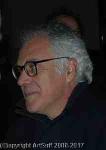Mimmo Paladino
Mimmo Paladino
Born: 1948
Biography:
Mimmo Paladino is an Italian sculptor, painter and printmaker.
In drafting this brief biography of Mimmo Paladino, I should like to start with the closing words written by the philosopher Arthur Danto in his essay for the Milanese anthology of the artist’s works: “ I must declare the eminence of Mimmo Paladino in the ranks of contemporary art. This is especially true of the outdoor installations. Nothing touches the great Mountain of Salt he created for Piazza del Plebiscito in Naples with its band of strewn archaic horses. The art world of the past quarter century has nothing to compare with it. There is something magically alchemical in the vision of archaic horses floundering up a pyramid of salt”.1 Here we find three observations that perfectly encapsulate the artist’s entire creative career, to an extent sanctioning the somewhat complex nature of his work. Danto was a keen intellectual who knew how to weigh his words, using them to convey a rich array of effects, with a well-structured understanding of contemporary art. In an almost solemn tone, he indelibly indicates Paladino’s position on the international scene, pointing to his eminence. The word “eminence” ultimately comes from the Latin eminens, which refers to a dominant role with regard to a subordinate one. Then there is the point he makes about the “outdoor installations” and, in particular about the Mountain of Salt, which, even though it dates from the 1990s and thus from the artist’s maturity, is a perfect blend of the methods that, ever since his artistic debut, Paladino has used to deal with the relationship with space – including urban space and in relation to his paintings. Lastly, there is a clear reference to a vision that is “magically alchemical” or, to put it more prosaically, to what I would call his instinctive ability to view objects as composite elements, which he brings together to create a new reduction of meaning.
Paladino was born in Paduli, Campania, on December 18, 1948, but grew up and trained in Benevento. He now lives in Rome and Milan, but still has a studio in the little town near Benevento. It should not be forgotten that the Longobard originality of the town and of the Sannite land is very much a part of what shaped his esthetic concepts, with the constant overlapping and emergence of the styles that were such a feature of the local culture from pagan times through to the papal period.
He made his debut in 1968 with a solo exhibition at the Galleria Carolina in Portici and engraving. However, his basic conception is always pictorial, even when three-dimensional, as in the case of It Will Have No Title, with the use of geometrical elements applied to the environment, the first result of which came in 1995. Painting, sculpture and engraving were the three media that most inspired his style throughout the following years and one might well assume that this is the ‘‘eminence” that Danto refers to, since it was clear that – like few other artists of the twentieth century – Paladino always revealed a different ambition in each discipline. In 1988 the critic Giovanni Carandente entrusted him with the main gallery in the Italian Pavilion at the 43rd Venice Biennale. Here Paladino showed an installation in which the management of space – created in part by a pictorial approach to sculpture – was of great impact. This type of approach returned in the early nineties in the Hortus Conclusus in Benevento, a garden in which architecture, the environment and objects all combined to form the work. These creations, which had a mysterious, “alchemical” air about them, emerged like apparitions, as constant epiphanies. This is an aspect that I find constantly in the work of this artist, who in 1994 was the first Italian to exhibit in the Forbidden City in Beijing. Here the views formed a complementary backdrop to the works on show, and this became a constant feature of all his urban projects. The Mountain of Salt dates from 1990. Originally created in Gibellina, it “appeared” in the Piazza del Plebiscito in Naples in 1995 and later, in 2011, in the Piazza del Duomo in Milan, when the city dedicated a major retrospective to him on the piano nobile of the Palazzo Reale. The nineties was a time of great experimentation and it is no coincidence that the Mountain became its symbol. The new millennium, as well as bringing a large number of exhibitions in which he was the protagonist or a guest, also brought the use of video. In 2006 Paladino made his short feature film Quijote, devoted to the work by Cervantes. Presented at the Venice Film Festival, the movie captures the essence of the art of the masterpiece in a highly imaginative series of evocations, sounds and inventions. Great literature is an underlying thread that, over the years, has led him to illustrate the icons of world culture, such as Tristes Tropiques, Ulysses, the Homeric poems, Pinocchio and, of course, Don Quixote. Paladino was back behind the camera in 2013 to film Labyrinthus for the fourth centenary of the death of the madrigal composer Gesualdo da Venosa. Here too, his collaboration with the world of music goes back a long way, with numerous mises en scène for opera houses, the creation of opera posters for Maestro Riccardo Muti and requests for music for his installations, as was the case in 1999 with Brian Eno for Sleepers, in London and then, in 2008, for the Ara Pacis in Rome.
More...
Wikipedia link: Click Here











